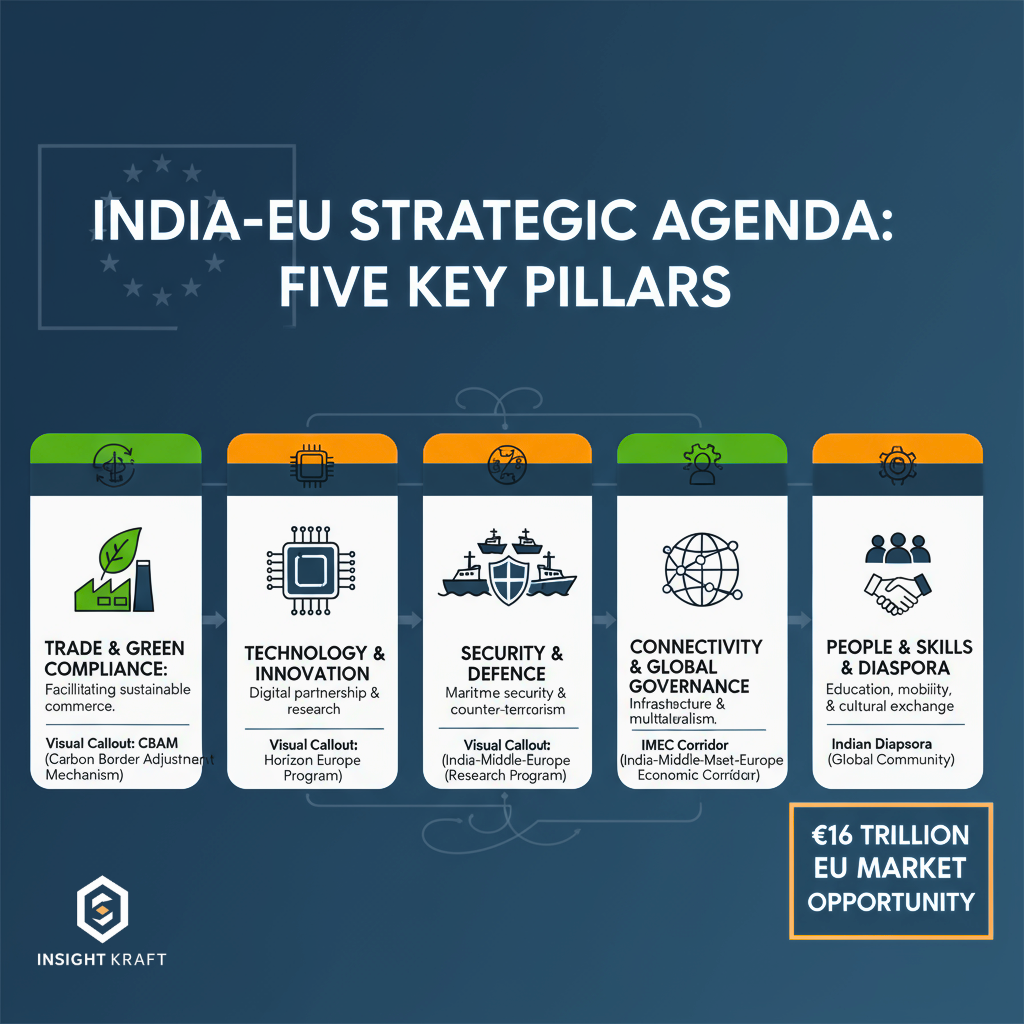
The European Union released its Joint Communication on a New Strategic Agenda with India this September, a significant move to shape a stable, multi-polar order. For the EU, this is a comprehensive and high-confidence offer grounded in its regulatory power. For New Delhi, the process is both promising and a rigorous test of its strategic autonomy, regulatory adaptability, and negotiating agility.
Trade, Green Compliance, and Economic Security
The EU’s goal to finalise a Free Trade Agreement (FTA) with India by the end of 2025 is highly ambitious. The EU communication makes it clear this is a priority, but success hinges on India lowering tariffs on sensitive goods like automobiles and wines. In return, Indian exporters in textiles, IT, and pharmaceuticals must grapple with the EU’s complex sustainability and product safety regulations.
The Carbon Border Adjustment Mechanism (CBAM) is a central piece of this puzzle. It will directly impact Indian steel, aluminum, and cement, pressuring SMEs to decarbonise. However, the EU document offers a crucial incentive: it notes that “a carbon price effectively paid in India will be deducted under the CBAM financial adjustment,” rewarding proactive Indian companies. This isn’t just a barrier; it’s an incentive structure for green upgrading.
The EU is also pushing beyond trade to economic security. Initiatives like the Trade and Technology Council (TTC) aim to build “resilient, trustworthy supply chains,” particularly in semiconductors, green tech, and active pharmaceutical ingredients (APIs). The novel concept of “Blue Valleys”—dedicated platforms for co-developing strategic value chains—could be a game-changer if they move from concept to concrete investment and standard-alignment.
Technology & Innovation: From Rule-Taking to Rule-Making
Europe is explicitly seeking stronger collaboration on critical technologies. The agenda proposes creating EU-India Innovation Hubs to catalyse joint projects in AI, quantum, and biotech. The offer for India to associate with Horizon Europe, the EU’s flagship research programme, is a significant opportunity, though it is contingent on finalising terms of association, including co-funding and adherence to common research norms. This would grant Indian researchers and startups unparalleled access to funding and networks.
This is where India’s strength becomes a major asset. The communication praises India’s “digital public infrastructure” and “vibrant startup ecosystem.” Europe doesn’t just see India as a market; it sees it as a co-innovator. India’s leverage lies in offering access to its vast datasets, talent pool, and scalable digital solutions. The proposed technical interoperability between India’s Aadhaar and the European Digital Identity Wallet is a sign of this mature, reciprocal partnership, though it will require careful navigation of India’s own concerns on data privacy and regulatory sovereignty.
Security & Defence: Navigating Differences and Maritime Focus
The agenda foregrounds a new EU-India Security and Defence Partnership, focusing on maritime security in the Indo-Pacific, cyber threats, and counterterrorism. This aligns with India’s goal to diversify its defence suppliers and deepen operational coordination, building on recent joint naval exercises.
However, a significant diplomatic challenge remains the conflict in Ukraine. The EU communication bluntly states its intention to “further engage with India on all aspects of countering Russia’s military aggression,” including preventing sanctions circumvention. Navigating this divergence will be critical for the partnership’s trajectory. While defence industrial cooperation is proposed, Europe’s fragmented defence procurement and stringent technology transfer rules mean progress will be measured.
Connectivity & Global Governance: The IMEC Test
The India-Middle East-Europe Economic Corridor (IMEC) is the flagship test for this new partnership. The EU commits to playing a “leading role” and investing through its Global Gateway initiative. However, the corridor’s success hinges on overcoming geopolitical instability and complex funding mechanisms. The related EU-Africa-India Digital Corridor, including the Blue Raman submarine cable, is a concrete example of the tangible infrastructure both sides can deliver.
Multilaterally, both powers are aligned on reforming the WTO and strengthening health security. The EU welcomes India’s bid for a UN Human Rights Council seat and its offer to host COP33 in 2028. This is a recognition of India’s growing legitimacy as a global agenda-setter.
People, Skills & Diaspora: The Human Bridge
With over 825,000 Indian citizens in the EU (the largest group of EU Blue Card recipients), people-to-people ties are a strategic asset. The EU proposes a “comprehensive framework of cooperation on mobility” to streamline migration for skilled workers, young professionals, and students. Initiatives like the planned European Legal Gateway Office in India aim to smooth the path for talent movement, starting with the ICT sector. This is a direct response to Europe’s demographic needs and India’s youth dividend.
What’s Really at Stake? Shaping the Terms of Engagement
The New Strategic Agenda is beyond partnership offer; it’s a negotiation over the architecture of the future global economy. The EU, confident in its regulatory power, is pushing for accelerated convergence. India, confident in its demographic and innovative power, must balance the benefits of alignment with the imperative to protect its regulatory sovereignty and developmental space.
The key for India is to proactively leverage its strengths—digital public infrastructure (DPI), a massive green transition market, and a skilled workforce—as core assets on the negotiating table. India’s goal would be co-create the agenda, shaping initiatives like Blue Valleys and Innovation Hubs to serve Indian economic priorities.
The stress test is real. But for Indian businesses, officials, and innovators, the question is to prepare to shape—not just follow—the rules that could rewire the global order for decades to come. The EU has laid its cards on the table; now India must play its strong hand strategically.
